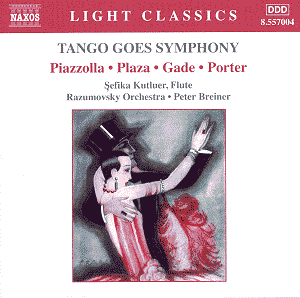This is a typical Naxos production: a disc of
quintessentially South American music rearranged and played by
East European musicians. The result is fun, but...
Tango is a difficult thing to define. To some
it is a dance, others a type of dance music. To Argentinians it
is both those, or more strictly a combination of the two. Yet
so much more - a sort of cultural essence that is full of seeming
contradictions. It is sleazy and smart, formal and sexually anarchic,
street/club music and concert hall music.
The history of tango, which is not a great deal
more than a century old, has been one of a general smartening
up that has taken the dance from the streets and dives of Buenos
Aires’ poor docklands to the ballroom, and the music to the concert
hall. Nowadays it belongs in all those places – flexibility is
part of that essence.
As far as the music goes, the most famous name
in the smartening up process is Astor Piazzolla who died ten years
ago. He took himself seriously as a composer (a one-time pupil
of Nadia Boulanger in Paris, would you believe) and used the tango
as the basis of much of his work. In a way he is indulging a kind
of cross-over activity. "Cross-over" is not a term I
like but I cannot think of another. It can mean a number of things,
the "classicalisation" of jazz is an example. I suspect
Piazzolla thought he was doing something just as much the other
way round. He said that if he were to write a baroque-style fugue
it would become "tanguificated" (sic). This is why the
title of the disc, Tango goes Symphony, at least in Piazzolla
terms, is something of a tautology – if it means anything at all.
All the more strange then that Piazzolla’s piece, Tangazo,
is not included because it was specifically written as a symphonic
study – so symphonic indeed that it has a slow introduction for
strings that is in exactly the same language as the opening of
Shostakovich’s Tenth Symphony. In fact it sounds dangerously
like a parody of it.
Instead, with the three pieces by Piazzolla we
get a guitar solo (Adios, Nonino) rearranged for trumpet
and piano and a piano piece which here acquires strings and flute.
The third piece, Oblivion, which Piazzolla did write
for symphony orchestra is rearranged so that its solo oboe is
switched to flute. And so what appears to be the raison d’être
for the disc is revealed – it is a vehicle for the Turkish flautist,
Şefika Kutluer. In arranging
the pieces for her, Peter Breiner ensures that as the pianist
(as well as conductor) he has plenty of juicy bits for himself.
Well he would, wouldn’t he. It is no bad thing for his piano playing
was one of the things I thought most enjoyable about the
disc.
Certainly Peter Breiner makes the most of Kutluer’s
talent, providing her with mini cadenzas and a range of special
effects including flutter-tonguing which suits the music very
well. The booklet notes are a trifle defensive about such arrangements
of the pieces. For example with reference to Oblivion:
"Kutluer proves that what was intended for oboe works
equally well on the flute". I do not agree. The piece has
a poignancy which loses some of that quality without the oboe’s
reedyness but that is not Kutluer’s fault. "Throughout the
album, her richly rounded tone falls beautifully upon the ear"
– an angular phrase, but I would not argue with the sentiment.
She is an outstanding flautist.
The chosen fourteen pieces contrast well and
Peter Breiner has ensured that there is plenty of contrasting
instrumental colour which helps to overcome the ubiquity of the
flute.
Most people will find something familiar on the
disc. Rodriguez’s La Cumparsita is one of the most famous
of tango pieces together with Jacob Gade’s Jealousy. Cole
Porter’s So in Love from Kiss me Kate is there and
two other pieces quote respectively from Rossini’s Barber of
Seville and Bach’s Toccata and Fugue in D minor.
So we have an enjoyable, eclectic package performed with polish
and the recorded sound has both bloom and zest to it. But …
Not long ago I was in Buenos Aires and went on
to the old San Telmo district which is where it all happens on
a Sunday morning – street theatre, stalls galore, pavement singers,
and of course, tango: amicrocosm of Argentinian culture. There
was a little area set aside for tangoing. Experts were able to
show off to the gathered crowd and a woman was there to encourage
any uncertain passer-by into an instant lesson – a sort of street
master class (tango is not something you just go and do – like
launching into a bop). The men who provided the live band looked
as if they had been dragged out of bed after a major South American
Saturday night out – or more likely they hadn’t been to bed at
all. They often played dreadfully out of tune but never did they
loose that sense of mood and panache that has got to stem from
something in the blood.
Peter Breiner et al never play out of
tune but without the requisite genes the pinch of je ne sais
quoi that makes tango what it is, is missing. But to be fair,
a studio in Bratislava is not a street with a crowd in Buenos
Aires. I suppose there is in operation that mysterious, impenetrable
law that ensures that ouzo and retsina never taste the same outside
Greece. Perhaps I am being irrationally wistful. I still enjoyed
the disc.
John Leeman

